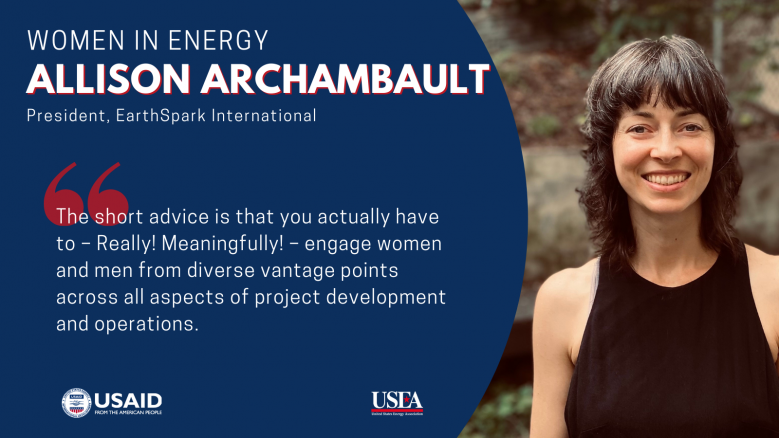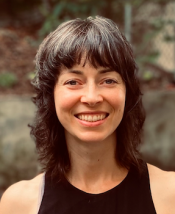
Women In Energy: Allison Archambault
The Women in Energy series is a joint project between USEA and USAID that was developed out of USEA’s Engendering Utilities Partnership, a program funded by USAID to improve gender policies and gender outcomes at their respective organizations.

Every month we feature a woman who has shown exemplary leadership. The women highlighted come from diverse backgrounds and roles, and they bring with them a unique perspective to gender equality within the energy sector.

Allison Archambault, president of EarthSpark International since 2010, won the U.S. Department of Energy’s 2017 C3E International Award for her 15 years of work in the clean energy field.
After writing her undergraduate thesis on rural solar electrification in Mali, she began renting solar panels in the Dominican Republic in 2003. From 2005-2008, she ran the Renewable Energy Partners Program for an early smart-grid startup, which was building distributed solar+storage solutions in the United States. Allison also worked with 3TIER, Inc. to promote the role of advanced weather prediction modelling for efficient siting and forecasting of large-scale renewables.
Allison was lead author of World Wildlife Fund’s 2012 report “Solar PV Atlas: Solar Power in Harmony with Nature – Towards 100% Renewable Energy” and has authored and co-authored several other technical and opinion pieces. Her development and implementation of 'Feminist Electrification' in EarthSpark business models won the 2018 UNFCCC Momentum for Change Award.
*USEA does not alter the substance of the responses from the women featured. The answers are their own.
Women in Energy Interview Questions
How have your education and career path led you to where you are now?
I needed a summer job in college and stumbled into climate. I specifically researched ways to save electricity at Tufts University. I ended up crawling around behind dorm vending machines (very dusty back there!) and installing gizmos that saved a surprisingly large percentage of the machine’s energy. It was a small dent in the overall university consumption, of course, but it was a great “A-ha!” moment for me that technology which should be obvious isn’t universally applied.
I worked full time while getting my master’s degree, and I pulled a few all-nighters researching and writing down the theory behind an aspect of what my colleagues at EarthSpark International and I were doing building microgrids in Haiti: “Feminist Electrification.” That school paper turned into a blog which turned into a methodology which won the United Nations UNFCCC Momentum for Change Award for being “a real-world example of what climate action looks like.” It was a great reminder for me that there’s value in stopping to research, document, and frame as a way to enhance processes and elevate impact. We’ve gone on to consult to other electricity providers on mainstreaming gender considerations. (The short advice is that you actually have to – Really! Meaningfully! – engage women and men from diverse vantage points across all aspects of project development and operations. Again, that’s something very obvious that isn’t universally applied.)
I had the enormous good fortune of meeting the visionary Ibrahim Togola in Mali in 2002 and working under Richard Hansen in the Dominican Republic in 2003—I met both of them while I was in college, and it totally changed my life. My work has bounced back and forth between clean tech in the United States and energy access in emerging markets. After working in the DR, I worked in the United States on climate and public health advocacy and then for some renewable energy start-ups that were at the forefront of smart grid.
What I love about my work now, building smart, solar, energy access microgrids in Haiti, is that it’s a joining of the smart grid, clean tech and energy access worlds. We actually had to launch a smart metering company, SparkMeter, for microgrids in emerging markets because nobody would take EarthSpark’s founder, Dan Schnitzer, and I seriously when we explained there was a huge need and vast potential market for low-cost, high-functionality smart meters for emerging market utilities. Now, nine years later, SparkMeter is the global leader in metering and grid analytics for this space and has active meters in 25 countries. Another case of obvious technology, not universally applied.
I sometimes chide my Stateside colleagues that, though my team and I face many challenges, it is actually easier to build a town-sized, solar-powered smart grid in rural Haiti than it is in Washington, D.C., where I live, or any city with an incumbent power provider that’s incentivized to maintain the status quo. In the communities where EarthSpark works in rural Haiti, there has generally never been a functioning grid, and the status quo is darkness, kerosene, and charcoal. The local communities with whom we partner are highly motivated to change that status quo. We get to build with today’s technologies, and we’re going 100% renewable energy for all future grids. We made a little video about that last month. Honestly if our tiny organization working in rural Haiti can go 100% renewable energy, I’d like to challenge everybody else to get serious about it too.
What obstacles have you experienced as a woman pursuing an education and career in the energy industry? What obstacles do women vying for leadership spots face in this sector?
Pandemic parenting crushed me. I didn’t know I could be so exhausted for so long. Of course, this is and should be a “parent” problem, but mothering and working from home has been…very real. God bless my team, funders and collaborators for accommodating kid-filled Zoom calls and post-bedtime work sessions. I hope everybody comes out of COVID a little kinder and gentler with each other and with ourselves. I’d like to think that’s the emerging leadership style of the future. Let’s all try to push or that.
Technology is transforming the traditional utility business model into a more modern interactive field. Some utilities view this transformation as an opportunity to focus on innovation and diversity, which research shows drives better business performance. How is your organization attracting, retaining and promoting more women into senior management positions to respond to this industry transformation?
Yes! The window is open for some fundamental shifts in the way people participate in the power systems – in all senses of those words. In Haiti we get to build systems from scratch, and people are getting power connections for the first time. That’s such a precious moment to define how the systems work. People are paying attention! There’s a big opportunity not only for education but also for collaboration. How *should* demand side management programs work? What role can the utility best play in electrification of local economic activities? Technology is opening up more potential for authentic co-creation by utilities, governments and communities in the responses to these questions all around the world.
In contrast to people’s keen interest in the topic of electricity in Haiti, I’ve seen people who have had electricity their whole lives tend to not pay much attention to it. But in an era of climate change, rooftop solar, EVs and VPPs, there are so many ways for people to get involved in their power systems that I sense a sea change here in the States too. As the game changes in the sector, of course there are plenty of new opportunities for equity, diversity and inclusion. Understanding and truly partnering with customers holds so much potential, and that can really happen best if the companies doing the outreach and partnership are themselves diverse. If the big companies aren’t leading on this, dare I say the small, diverse, and thoughtful companies may soon become the big ones?
What changes in the sector at large do you think have launched more women into leadership positions?
So many phenomenal women and men have opened the doors for women to lead. I’m very happy to see both social pressure and smart research pushing the sector towards being more generally diverse. Business outcomes are better when leadership teams are diverse. C3E, WCEE, WRISE and ENERGIA have all been important influences both to me personally and to the sector at large. I encourage women and men to get involved with these organizations and follow their work.
What are some untapped actions the energy and electricity sector could focus on to accelerate change, increase diversity, and foster a better gender balance in the boardroom?
First, family caregiving is still falling disproportionately to women. We need company policies to authentically encourage men to do this work, and we particularly need men in leadership positions to set the example by taking parental leave, holding their kids through Zoom calls, excusing themselves from the workday to attend to an urgent family matter.
Any entity that is truly committed to diversity will be able to figure this out and meaningfully move in the right direction. I say that knowing that the details can feel difficult. In Haiti right now, our technician staff is entirely male. That’s not where we want to be, and we’re working on setting up specific onboarding opportunities for women and girls from the communities where we work. Certainly, there are plenty of brilliant women capable of doing the work with the right training and opportunities. I’d love to hear advice and success stories from your readers.
For gender balance in the boardroom, the way to get more women on the boards is to… appoint and retain more women board members. When we speak out loud the things that need to happen, it’s all actually very straightforward. Here, there is no specialized onboarding needed. There are plenty of brilliant women ready and qualified to serve on boards and in executive positions.
